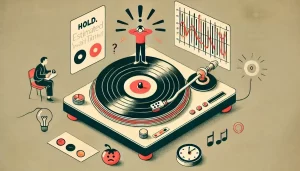If you’ve ever waited on hold and felt your blood pressure rise with each looping note of tinny music, you’re not alone. Hold music has become a near-universal symbol of customer service frustration — and for good reason. But what exactly makes it so unbearable? And more importantly, what can businesses do to improve it?
Let’s unpack the psychology behind hold music, examine what makes it frustrating, and explore practical ways to fix it.

The Psychology Behind Hold Music
When a customer is placed on hold, they’re already in a potentially tense state — needing help, facing a delay, and unsure of how long the wait will last. Add in repetitive, low-fidelity music, and that emotional temperature rises fast.
According to Amazing Voice, the brain craves variety and meaningful stimulation. But most hold music delivers neither. Instead, it creates a monotonous soundscape that emphasizes the passage of time — the very thing callers are trying to ignore.
Psychologist Arfa Khan explains on LinkedIn that hold music can even make people feel less patient, depending on tempo, volume, and predictability. When music lacks variation or seems irrelevant to the caller, it worsens the emotional experience.
Common Complaints About Hold Music
So what exactly drives people up the wall when they’re on hold?
Repetitive loops: Many callers hear the same 15–30 seconds of audio played over and over. This creates a mental loop that amplifies irritation, especially when callers are left waiting for extended periods.
Poor sound quality: Hold music is often compressed for phone systems, resulting in crackly, distorted audio that grates on the ears.
Generic or mismatched tone: A cheery ukulele track might feel jarring if you’re calling about a billing issue. Music that doesn’t reflect the tone of the interaction creates emotional dissonance.
A fascinating breakdown by Startle Music refers to this phenomenon as on-hold rage — the specific kind of irritation tied to being trapped in a waiting loop with no control over the environment.
Three predictions, for contact center executives to consider, on how AI will shape the future of contact centersHow AI will Transform Contact Centers in the Next 5 Years
Why Silence Isn’t the Solution
It might be tempting to remove hold music altogether — but silence often makes the experience worse. Without music or messaging, callers may wonder if the call has been disconnected. As CX Today explains, silence is a “CX killer” that increases anxiety and leads to higher hang-up rates.
Instead, smart sound design and thoughtful messaging are key to keeping callers engaged.
What Makes Good Hold Music?
The best hold music is more than just background noise — it’s a carefully crafted part of the customer experience. According to Snap Recordings, effective hold music should:
-Match the brand voice and mood of the call
-Be professionally recorded and free of distortion
-Include occasional voice updates or estimated wait times
-Offer smooth transitions between tracks or loops
Startle Music’s research also found that even small changes — like switching to instrumental tracks or adding environmental soundscapes — can significantly improve the perception of wait time.
How AI and Personalization Can Help
What if your hold music didn’t have to be one-size-fits-all?
AI-driven systems like My AI Front Desk are already experimenting with personalized hold music that adapts to caller preferences or integrates with CRM data to align tone and mood with the customer profile. This could mean playing calming jazz for one caller and upbeat electronic music for another.
OmniVoice offers tools that allow businesses to upload custom playlists, change tracks by daypart, or even rotate hold messages dynamically — making the on-hold experience feel more curated and less like a punishment.
Additional Tips for Improving Your Hold Experience
-Give callers options: Some businesses allow users to choose between music genres, wait in silence, or request a call-back instead.
-Update regularly: Swap out your hold music at least quarterly to prevent overexposure and fatigue.
-Add voice messaging smartly: Insert helpful, concise updates or soft upsells to reduce perceived wait times.
-Minimize background distractions: Even great music can be undermined by background noise when the call resumes. Tomato.ai’s AI-powered noise cancellation helps agents sound crystal clear the moment they start speaking — ensuring a smooth transition from hold to human.
As HowStuffWorks points out, one of the most powerful psychological tricks is to give people the sense that their time is being used meaningfully — even if they’re just listening.
Want to dig deeper into call center terms and best practices? Check out our Call Center Glossary for more insights into improving the full caller journey.
Make Every Second on the Line Count
Hold music doesn’t have to be an afterthought. With thoughtful selection, smart personalization, and modern AI tools, businesses can transform a traditionally frustrating moment into one that reinforces brand trust and soothes caller anxiety.
After all, the time customers spend on hold is still part of their experience — and it’s worth getting right.
Want to upgrade your callers’ experience from the moment the line picks up? Learn more about how Tomato.ai can help you reduce frustration with AI-powered accent softening and real-time noise cancellation.
FAQ
What makes hold music so annoying?
Repetitive loops, poor sound quality, and irrelevant music choices all contribute to the frustration. The lack of control over the listening experience makes wait times feel longer and more irritating.
Can hold music actually improve customer satisfaction?
Yes. When hold music is carefully selected, refreshed regularly, and paired with helpful messaging, it can reduce perceived wait times and create a more pleasant overall experience.
Should businesses allow customers to choose their hold music?
Offering music genre options — or even the ability to wait in silence — gives callers a sense of control, which can improve patience and satisfaction.
How can AI improve hold music?
AI tools can personalize hold music based on caller preferences or CRM data. This customization can align the tone with the customer’s mood or intent, leading to a more relevant experience.





